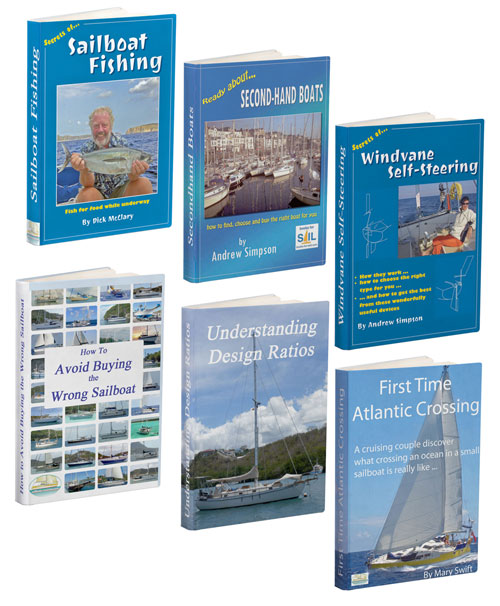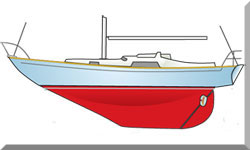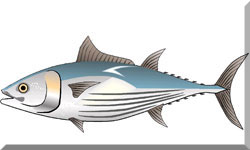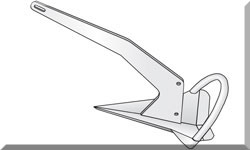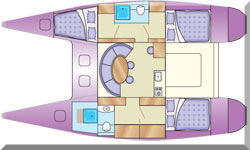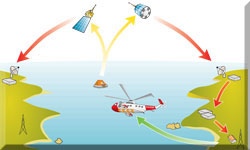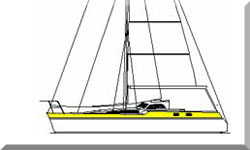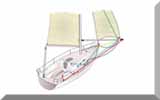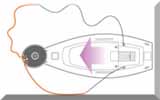- Home
- Offshore Seamanship and Heavy Weather Tactics
- Multihull Autopilot Selection
Multihull Autopilots: They're Not Your Average Electronic Helmsman
In a Nutshell...
Choosing the right system for multihull autopilot selection is a distinct challenge because these boats are fundamentally different from monohulls. Unlike a slow-reacting monohull, your cat or tri demands an electronic helmsman with lightning-fast processing speed, sophisticated 9-axis sensors, and powerful drive units. Why? They need to manage your boat's rapid speed changes, quick motion in a chop, and those huge shifts in apparent wind angle. As an experienced ocean sailor, my advice is simple: always over-spec your unit based on your boat’s fully laden displacement and stick to high-performance systems from the outset. It’s the best way to guarantee safety, efficiency, and comfort offshore.
 A modern take on a cruising trimaran — the Neel 45
A modern take on a cruising trimaran — the Neel 45Table of Contents
- The Multihull Autopilot Challenge
- The Ultimate Choice: Below-Deck Systems for Offshore Multihulls
- Comparison of Leading Autopilot Systems for Multihulls
- System Integration & Collision Avoidance
- Installation & Calibration: Precision is Power
- Cockpit Autopilots: Tiller & Wheel Options
- Power, Weight & Windvanes: Complete the Picture
- Long-Term Maintenance & Operational Checklist
- Contingency & Failure Management: Always Have a Plan B
- Summing Up
- Frequently Asked Questions (FAQs)
So, you're the proud owner of a sailing multihull—a sleek catamaran slicing through the waves or a trimaran with its distinctive grace. You already know these boats aren't like your average monohulls, and when it comes to selecting an autopilot, the same holds true.
While the fundamental goal of keeping you on course remains, there are some distinct things to consider when picking an electronic helmsman for your multi-hulled beauty. We can't simply choose a pilot based on boat length; we’ve got to think about the physics. Let's look at what makes multihull autopilot selection a little different for these fantastic vessels.
The Multihull Autopilot Challenge
Multihulls force an autopilot to work in ways a monohull pilot rarely experiences. The core difference comes down to speed and stability, and believe me, a sluggish system will have you constantly fighting the helm.
Speed & Rapid Apparent Wind Shift
First off, get ready for speed. Multihulls, especially those designed for performance, are the sports cars of the sailing world. They leap forward in a puff of wind and can quickly hit speeds that would leave a monohull well in their wake. This rapid acceleration, and the quick shifts in the apparent wind angle that come with it, mean your autopilot needs to be incredibly sharp.
It's not enough for it to react slowly; it needs a fast processing speed and a lightning-quick response time to keep you tracking straight. Imagine a hesitant driver trying to keep a sports car in its lane during rapid acceleration—that's what a sluggish autopilot would be doing on your multihull, likely leading to frustrating oscillations and deviations from your intended path.
A key feature here is the ability to steer to a consistent apparent wind angle (AWA), especially when you're enjoying a fast reach. Since multihulls are incredibly sensitive to apparent wind, a smart pilot that can keep the boat locked on that AWA is a real game-changer for efficient sailing and VMG.
The Multihull Motion: Quick, Not Rolling
Then there's the way multihulls dance with the waves. Unlike monohulls that tend to lean into a swell, multihulls generally experience less of that comfortable rolling motion. However, they can have a quicker, almost jerky response to waves, especially in a good chop or confused seaway.
Your autopilot needs to be smart enough to differentiate between a genuine change in course and just the boat’s natural motion. If it overreacts to every little wiggle, you'll end up with an uncomfortable ride and your batteries will be working overtime. This is where advanced algorithms and solid-state 9-axis AHRS (Attitude Heading Reference Sensor) technology come into play. They can filter out those rapid, less significant movements while still being alert to real course changes. This capability dramatically reduces helm movement, which saves energy and dramatically improves the feel of the boat under pilot.
Dual Rudders & Steering Linkages
The very structure of many multihulls also presents unique considerations. Catamarans, with their wider beam, can have different leverage and forces acting on the steering system compared to a slender monohull. Plus, most catamarans sport dual rudders, offering excellent control but requiring the autopilot to manage both in perfect harmony. You'll need to think about the type of steering linkage connecting those rudders and how the autopilot's drive unit will interface with it to ensure smooth and coordinated steering, whether it's via a cross-bar or separate steering lines.
The Ultimate Choice: Below-Deck Systems for Offshore Multihulls
While cockpit-mounted tiller and wheel pilots are fantastic for coastal cruising, for the high-intent, experienced sailor undertaking serious offshore passages, a below-deck system is the optimal—and often necessary—choice for robustness, power, and long-term reliability.
Hydraulic versus Mechanical Linear Drives
Below-deck autopilots typically use a linear drive to connect directly to the rudder quadrant or tiller arm. For multihulls, which are often heavier than their sleek profile suggests once fully loaded with cruising gear, the choice often comes down to two main drive types:
- Mechanical Linear Drives (Electric): These drives use an electric motor and clutch mechanism to move a ram. They are generally simpler, easier to maintain, and crucially, they offer zero backdrive resistance when disengaged, meaning the helm feels completely free for manual steering. They are typically rated for boats up to about 20 tonnes. For most cruising catamarans up to 45 or 50 feet, a heavy-duty electric linear drive is a robust and efficient solution.
- Hydraulic Linear Drives (Self-Contained): These are self-contained hydraulic systems that are generally more powerful and are often rated for boats up to 35 tonnes or more. While they offer immense torque to hold the boat in heavy weather, they can consume more power and, critically, they may introduce a slight resistance or ‘numbness’ to the helm even when in standby mode due to oil circulation in the pump, unless they are a high-quality model designed with a proper bypass valve. For a performance multihull where feel and minimal resistance are key, this subtle difference matters.
For a fast multihull, many experienced sailors prefer the electric linear drive because it disengages completely, preserving the feel of the boat under manual control, and its power consumption is often lower under typical loads. The key is ensuring the chosen drive unit is well over-spec’d for the maximum anticipated load, as a Neel 45 trimaran once overtook my 38-foot monohull like I was drifting under bare poles, showing just how fast these boats can load up the steering system. Making these high-stakes equipment decisions is fundamental to Mastering Offshore Seamanship, the broader set of skills and planning that guarantees your safety and efficiency at sea.
Sensor Technology: The Brains of the Operation
Modern autopilot performance is defined by its core sensor. Gone are the days of the simple fluxgate compass. Leading manufacturers now use solid-state Inertial Measurement Units (IMUs), often referred to as 9-axis AHRS sensors.
| Feature | Importance for Multihulls | Benefit |
|---|---|---|
| 9-Axis Sensing | Critical | Measures Yaw, Pitch, Roll, and Acceleration, allowing the computer to distinguish between actual course error and hull motion (chatter). |
| Adaptive Algorithms | High | The autopilot learns the boat's steering characteristics and adjusts its gain (aggression) based on speed and sea state, improving efficiency and reducing constant correction. |
| NMEA 2000 Integration | Essential | Allows seamless connection to wind instruments and GPS, unlocking critical steering modes like steering to True Wind Angle or Apparent Wind Angle. |
| Rudder Feedback | Moderate & High | An absolute must for below-deck systems on performance boats to ensure the computer knows the exact rudder position, which is essential for managing dual rudder systems in sync. |
Comparison of Leading Autopilot Systems for Multihulls
An experienced sailor doesn't just look at features; they consider the whole package—cost, power, and manufacturer support. This table offers a high-level comparison focused specifically on robust below-deck solutions for serious multihull cruising.
| System Line | Primary Sensor Tech | Drive Type Focus | Key Multihull Benefit | Estimated Installed Cost (GBP) |
|---|---|---|---|---|
| Raymarine Evolution | EV-1 (9-axis AHRS) | Electric Linear/Hydraulic | 'Evolution Ai' adaptive steering & wide user base. | £3,500 – £6,500 |
| Garmin Reactor 40 | Solid-state 9-axis AHRS | Electric Linear/Hydraulic | Fast commissioning & tight integration with Garmin MFDs. | £3,200 – £6,000 |
| B&G H5000/Triton | Precision-9 (9-axis AHRS) | NAC-3 Computer/Linear | Superior wind steering algorithms & racing heritage. | £4,000 – £7,500 |
| Simrad AP44/NAC-3 | Precision-9 (9-axis AHRS) | NAC-3 Computer/Linear | Robust commercial-grade components & reliable performance. | £3,800 – £7,000 |
Note: Costs are estimates for a complete below-deck system (sensor, computer, control head, & heavy-duty drive) and exclude installation labour.
System Integration & Collision Avoidance
Choosing the right hardware is only half the battle; the pilot's real performance lies in how it integrates seamlessly with the rest of your boat's electronic kit. For a multihull, where speed and traffic awareness are vital, integration with your Multi-Function Display (MFD) and collision avoidance systems is non-negotiable.
Autopilot & the Digital Lookout
The autopilot should function as a sophisticated extension of your navigation suite, not a standalone gadget. Via the NMEA 2000 backbone, modern systems utilise data from:
- AIS (Automatic Identification System): While the pilot won't actively steer around an AIS target on its own, its link to the MFD lets you quickly assess the risk of a Constant Bearing Decreasing Range (CBDR) situation. The system can alert you to a developing threat, at which point you manually disengage the pilot and effect a course alteration in accordance with the COLREGs.
- Radar: Similarly, the autopilot's knowledge of GPS and heading allows for precise radar overlay on your chart, improving situational awareness. Advanced MFDs with MARPA (Mini-Automatic Radar Plotting Aid) can track multiple targets. Though the pilot won't automatically respond to radar, a well-integrated system ensures all the necessary data is on one screen so you can make rapid, informed decisions—vital when navigating a fast multihull through busy shipping lanes.
- Track Following: The most practical benefit of integration is the ability to steer accurately to a specific route or track (sometimes called Track Mode). This is far more precise than a simple Heading Hold mode and ensures you stick to a planned route, saving both time and distance over a long passage.
Installation & Calibration: Precision is Power
On a multihull, a poorly installed or calibrated autopilot will perform miserably, no matter how much you spent on it. The sheer speed and quick motion of these boats truly magnify any error in the sensor readings.
The Critical Location of the Sensor Core
The primary component—the 9-axis AHRS sensor core (like the Raymarine EV-1 or B&G Precision-9)—must be installed correctly:
- Location: Install the sensor as close to the boat's Centre of Gravity (COG) as possible, ideally in a dry, protected area below the cockpit sole. Keeping it low and central minimises the effect of pitch and roll on its readings, which is essential given the multihull's quick movement.
- Alignment: The sensor must be aligned precisely with the vessel's fore-and-aft line. Any misalignment here will translate directly into a permanent heading error that the pilot will constantly fight.
The Non-Negotiable Calibration Process
Once physically installed, the system needs to be calibrated. This process isn't a five-minute job; it’s a vital procedure that defines the system's performance. It involves:
- Initial Power-up & Commissioning: Making sure the system can ‘talk’ to all components via NMEA 2000.
- Compass Calibration: Performing the magnetic calibration (a series of slow turns) to compensate for local magnetic deviation.
- Rudder Calibration: The system learns the full range of rudder travel and the boat's rudder characteristics—critical for synchronising dual rudders.
- Dockside & Sea Trials: This is the most important step. The pilot learns the boat’s inertia and response characteristics. Systems with "self-learning" or Adaptive Algorithms will continually refine their performance over the first few hours or days of use. As an ocean sailor, my rule is to never trust a pilot on an ocean crossing until it has successfully completed at least 50 hours of use in varied conditions.
Cockpit Autopilots: Tiller & Wheel Options
While below-deck systems are the gold standard for offshore, cockpit pilots remain a viable choice for smaller and lighter multihulls, or as a reliable backup system. The same rules of rapid response and over-specifying still apply.
Tiller-Steered Multihulls
While tiller-steered multihulls might seem like a straightforward match for standard tiller pilots, their faster speeds, different motion, and sensitivity to apparent wind mean you'll want to seriously consider models that can handle these demands effectively.
- Response Speed and Processing Power: Prioritise models designed with a more powerful drive and faster internal processing. The older Simrad TP32 is often favoured over the TP10 for its higher thrust and quicker action.
- Intelligent Sensing: Systems like the Raymarine EV-100 Tiller, which use an intelligent EV-1 sensor core, are beneficial. This advanced sensor is designed to adapt to changing vessel dynamics, which is a major advantage for the quicker movements of a multihull.
- The Offshore Option: The Pelagic Autopilot, while not a mainstream brand, has earned a robust track record among offshore sailors for its gyro-based steering and general tenacity, making it a compelling option for smaller multihulls needing a reliable electronic crew member.
Important Considerations: Multihulls, even if relatively light, can generate significant forces on the tiller at higher speeds. You must ensure the tiller pilot you choose has a sufficient thrust rating to handle these loads without being overworked.
Wheel-Steered Multihulls (Cockpit)
For wheel-steered multihulls using a cockpit-mounted drive, you'll want to focus on systems that pair an advanced sensor with a robust drive unit.
- Raymarine Evolution EV-100 Wheel Pilot: This system's strength for multihulls lies in its intelligent EV-1 sensor core. The 9-axis sensing and 'Evolution Ai' provide precise and confident course keeping, which is crucial for the faster speeds and potentially more abrupt movements a multihull experiences.
- Garmin Reactor 40 with Wheel Drive: Known for its responsive performance, the Reactor 40 series also boasts solid-state 9-axis AHRS technology. Its ability to react quickly and minimise heading error, even in dynamic conditions, makes it a strong contender, particularly for those integrated within the Garmin ecosystem.
- B&G Systems: B&G's integrated systems, often leveraging the NAC-2 or NAC-3 computer with a dedicated drive unit, are renowned for their sophisticated sailing algorithms, including exceptional wind steering capabilities. For a performance catamaran or trimaran, the B&G ecosystem is difficult to beat when it comes to performance sailing.
Power, Weight & Windvanes: Complete the Picture
An autopilot is a component of a larger system, and its selection affects every aspect of your boat, from performance to power management.
The Constant Draw: Power Efficiency
Keeping those batteries topped up is crucial on any sailing vessel. The faster response and potentially more frequent corrections an autopilot might make on a lively multihull will inevitably lead to higher power consumption than a sluggish pilot. Choosing an efficient system is non-negotiable for extended cruising. High-performance, integrated systems, while sometimes having a higher peak draw, often consume less total power over time because their advanced algorithms steer the boat more efficiently and with fewer, smoother movements. The result is less rudder articulation and, therefore, a lower overall amperage draw.
Weight: Keeping the Ends Light
Weight is always a concern on a boat, but it can be particularly critical on multihulls. You must keep weight out of the bows and sterns to avoid pitching, which dramatically impacts performance and comfort. Opting for a lightweight and efficient autopilot system—and carefully locating the heavy components like the drive unit and course computer centrally—is paramount to maintaining your multihull's performance and agility. Every saved kilogram contributes to better handling and speed.
Windvanes on Multihulls: An Offshore Compromise
What about going old school with a windvane? While these purely mechanical self-steering systems are a proven solution for long offshore passages on monohulls, their suitability for multihulls is often debated.
Some argue that the responsiveness of multihulls to apparent wind and the complexities of setting up a windvane to effectively handle the wider hull and potentially dual rudders in all conditions make electronic autopilots a more practical choice. That being said, some adventurous multihull owners do successfully use windvanes, especially when power conservation is the absolute priority for extended cruising. However, I suspect that successful application is likely to have been achieved on a multihull of a more pedestrian nature, not a high-speed cruiser. For true performance and ease of use, the electronic pilot remains king.
Long-Term Maintenance & Operational Checklist
Selecting a system is just the start. An offshore sailor must adopt a proactive maintenance regimen to prevent failure miles from shore. Over-delivering here means giving the reader actionable, expert advice for the lifespan of the equipment.
Proactive Checks for Autopilot Longevity
- Inspect the Drive Unit Linkage: On a multihull, forces are high. Regularly check for corrosion, wear on pins and rudder quadrants, and ensure the steering system’s friction points (like bearings and bushes) remain free and well-lubricated. Any added friction translates directly into higher amperage draw and increased wear on the drive motor.
- Cable & Connection Integrity: Autopilots are power-hungry under load. Check all power and signal cables (especially NMEA 2000 backbone connections) for chafing, corrosion, or loose terminals, particularly in the damp environment of a bilge or lazarette. A minor voltage drop can cause erratic behaviour or outright failure.
- Drive Unit Fluid (Hydraulic Systems): If you opt for a hydraulic drive, check the hydraulic reservoir for fluid levels and condition annually. Air in the system leads to sloppy steering and increased wear.
- Software Updates: Regularly updating the firmware on the sensor core and control head is essential. Manufacturers frequently release updates to refine the steering algorithms, often improving efficiency and reducing power consumption—a significant benefit for long-term multihull cruising.
Contingency & Failure Management: Always Have a Plan B
Autopilots fail. That's a simple fact of life offshore, and on a multihull, losing your electronic helm can be particularly arduous given the potentially high helm loads. A professional sailor plans for this reality.
The Three Most Common Failure Points
From my experience, failures usually boil down to one of three areas:
- Drive Unit Overload: This is the most common mechanical failure, where the linear drive or wheel pilot is overworked, especially in heavy following seas where the boat attempts to surf. This often leads to sheared pins, damaged gearboxes, or burnt-out electric motors. This is why over-specifying the drive unit is so crucial for multihulls.
- Power & Electrical Issues: The system suddenly loses power due to a loose connection, a blown fuse, or general low voltage. Multihulls are complex electrically, so a faulty crimp or a weak battery bank can cripple the pilot.
- Sensor Failure: A sudden failure of the heading sensor (the EV-1/Precision-9) or rudder feedback unit (RFU) will immediately send the pilot offline.
The Multihull Backup Strategy
Your contingency plan should ensure you can maintain course with minimal fuss:
- Dual Autopilots (The Gold Standard): Many serious offshore multihulls carry a completely separate, secondary electronic pilot system. If the primary below-deck system fails, a robust, over-spec’d tiller pilot or wheel pilot can be quickly deployed as a reliable backup, ensuring you can still follow a compass or GPS track.
- Manual Emergency Steering: Every multihull should have an accessible emergency steering system (often an emergency tiller). Practise using it in calm conditions.
- Sail Trim Steering: An art form for any offshore sailor, but particularly effective on a fast, stiff multihull. By balancing the main and headsails, you can significantly reduce the load on the rudder, allowing the boat to track a course with only minimal manual input, saving precious power for other systems.
Summing Up
The challenge of multihull autopilot selection boils down to respecting the boat's inherent nature: speed, responsiveness, and unique steering architecture. Don't compromise; a system that’s merely rated for your boat's weight class isn't enough. You must choose a pilot with a powerful drive unit and the latest 9-axis sensor technology that can react and think as quickly as your boat sails. By prioritising a robust, responsive, and intelligently integrating system, you’re not just buying an electronic helm; you’re investing in your safety, comfort, and the overall efficiency of your offshore passages.
This article was written by Dick McClary, RYA Yachtmaster and author of the RYA publications 'Offshore Sailing' and 'Fishing Afloat', member of The Yachting Journalists Association (YJA), and erstwhile member of the Ocean Cruising Club (OCC).
Frequently Asked Questions (FAQs)
Q1: What is the most critical feature an autopilot needs for a fast catamaran?
Q1: What is the most critical feature an autopilot needs for a fast catamaran?
A: The most critical feature is the processing speed and the use of a 9-axis AHRS sensor. This allows the autopilot to instantaneously differentiate between a genuine course change and the boat's rapid motion in a seaway, leading to fewer corrections and greater efficiency.
Q2: How should I calculate the displacement for choosing an autopilot drive?
Q2: How should I calculate the displacement for choosing an autopilot drive?
A: Always use your multihull’s fully laden displacement—the weight of the boat with all cruising gear, fuel, water, and crew aboard—not the manufacturer’s light ship displacement. Choose a drive unit rated at least 20% to 30% above this figure to ensure reliable performance in heavy weather.
Q3: Can a standard tiller pilot handle a fast multihull?
Q3: Can a standard tiller pilot handle a fast multihull?
A: Entry-level tiller pilots (e.g., TP10) are generally insufficient due to low thrust and slow response time. You must choose a high-end model (e.g., Simrad TP32, Raymarine EV-100) or a specialised unit like the Pelagic to cope with the higher loads and faster steering demands of a multihull.
Q4: Is a rudder feedback sensor necessary on a multihull?
Q4: Is a rudder feedback sensor necessary on a multihull?
A: Yes, for any below-deck system, a rudder feedback sensor is highly recommended. It’s crucial for the autopilot computer to know the exact position of the rudders, which helps ensure smooth and perfectly coordinated steering, especially with dual rudder setups.
Q5: What is the benefit of steering to Apparent Wind Angle (AWA) on a multihull?
Q5: What is the benefit of steering to Apparent Wind Angle (AWA) on a multihull?
A: Multihulls are highly sensitive to apparent wind. Steering to a constant AWA keeps the boat sailing at its optimal performance angle, which translates directly into better boat speed and a more efficient course, especially when reaching.
Q6: Does a below-deck hydraulic drive create resistance when steering manually?
Q6: Does a below-deck hydraulic drive create resistance when steering manually?
A: High-quality, below-deck electric linear drives offer zero resistance. Hydraulic drives, even in standby, can sometimes introduce a slight drag due to oil circulation unless they feature a solenoid or bypass valve that completely isolates the helm, which is why an electric linear drive is often preferred for high-performance sailing yachts.
Q7: Where is the best place to locate the autopilot's sensor core on a catamaran?
Q7: Where is the best place to locate the autopilot's sensor core on a catamaran?
A: The sensor core should be located as close as possible to the boat’s Centre of Gravity (COG). This is typically low and central, often beneath the saloon floor, to minimise interference from the boat’s pitching and rolling motions, which are exaggerated away from the centreline.
Resources Used
- Simrad Yachting Buyer's Guide - Autopilot Systems
- West Marine Advisor - Selecting an Autopilot
- Yachting World & Sailing World Articles on High-Performance Autopilots
- Raymarine Online Guides - Autopilot Drive Units and Evolution Technology
- Expert discussions on linear drive selection (mechanical versus hydraulic) from offshore sailing forums.
Recent Articles
-
Modern Boat Electronics and the Latest Marine Instruments
Dec 20, 25 05:27 PM
Should sailboat instruments be linked to the latest boat electronics as a fully integrated system, or is it best to leave them as independent units? -
Hans Christian 43: Classic Bluewater Cruiser & Liveaboard Sailboat
Dec 10, 25 04:37 AM
Explore the Hans Christian 43: a legendary heavy-displacement, long-keel sailboat. Read our in-depth review of its specs, design ratios, and suitability for offshore cruising and living aboard. -
Planning Your Sailboat Liveaboard Lifestyle: An Ocean Sailor's Guide
Dec 06, 25 05:18 AM
Seasoned sailors share their methodical risk analysis for planning a secure Sailboat Liveaboard Lifestyle, covering financial, property, and relationship risks.
